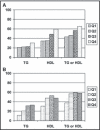Association of lipid abnormalities with measures and severity of adiposity and insulin resistance among overweight children and adolescents
- PMID: 19817943
- PMCID: PMC8673010
- DOI: 10.1111/j.1751-7176.2009.00056.x
Association of lipid abnormalities with measures and severity of adiposity and insulin resistance among overweight children and adolescents
Abstract
Obesity and lipid abnormalities in children may increase premature cardiovascular disease risk, but the relationship of dyslipidemia with adiposity among obese children is not well defined. The authors performed a cross-sectional analysis of children and adolescents (N=698) in 3 age groups (3-8 years, 9-11 years, and 12-18 years; 53% female, 81% African American, and 16% Hispanic) attending an obesity treatment program. More than 50% of the sample had abnormal levels of triglycerides (TG) or high-density lipoprotein (HDL) cholesterol or both. Only HDL cholesterol and TG were significantly associated with adiposity measures and insulin resistance (measured by homeostasis model assessment [HOMA]) and only in adolescents. All measures of adiposity, adjusted for age and sex, among adolescents were modest predictors of abnormal TG and HDL cholesterol, but these associations were attenuated when adjusting for HOMA. Despite the high prevalence of dyslipidemia in overweight children and adolescents, severity of adiposity appears to be a poor predictor of lipid values except among adolescents. Insulin resistance may in part mediate the relationship of adiposity and dyslipidemia among obese adolescents.
Figures

References
-
- MacLean R, Chockalingham A. The global burden of cardiovascular diseases. Can J Cardiol. 1999;15(suppl G):17G–19G. - PubMed
-
- Newman WP III, Freedman DS, Voors AW, et al. Relation of serum lipoprotein levels and systolic blood pressure to early atherosclerosis: the Bogalusa Heart Study. New Engl J Med. 1986;314:138–144. - PubMed
-
- Pathobiological Determinants of Atherosclerosis in Youth (PDAY) Research Group . Relationship of atherosclerosis in young men to serum lipoprotein cholesterol concentration and smoking. JAMA. 1990;264:3018–3023. - PubMed
-
- Mahoney LT, Burns TL, Stanford W. Coronary risk factors measured in childhood and young adult life are associated with coronary artery calcification in young adults: the Muscatine Study. J Am Coll Cardiol. 1996;27: 277–284. - PubMed
-
- Davies H. Atherogenesis and the coronary arteries in childhood. Int J Cardiol. 1990;28: 283–292. - PubMed
MeSH terms
Substances
LinkOut - more resources
Full Text Sources
Medical
Miscellaneous

